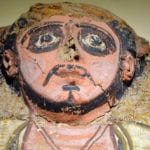 Miscellaneous
Miscellaneous  Miscellaneous
Miscellaneous  Our World
Our World 10 Green Practices That Actually Make a Difference
 Humans
Humans Ten Historic Men Who Deserve Way More Credit Than They Got
 Movies and TV
Movies and TV The 10 Most Heartwarming Moments in Pixar Films
 Travel
Travel Top 10 Religious Architectural Marvels
 Creepy
Creepy 10 Haunted Places in Alabama
 History
History Top 10 Tragic Facts about England’s 9 Days Queen
 Food
Food 10 Weird Foods Inspired by Your Favorite Movies
 Religion
Religion 10 Mind-Blowing Claims and Messages Hidden in the Bible Code
 Facts
Facts 10 Things You Never Knew about the History of Gambling
 Miscellaneous
Miscellaneous Ten Groundbreaking Tattoos with Fascinating Backstories
 Our World
Our World 10 Green Practices That Actually Make a Difference
 Humans
Humans Ten Historic Men Who Deserve Way More Credit Than They Got
Who's Behind Listverse?

Jamie Frater
Head Editor
Jamie founded Listverse due to an insatiable desire to share fascinating, obscure, and bizarre facts. He has been a guest speaker on numerous national radio and television stations and is a five time published author.
More About Us Movies and TV
Movies and TV The 10 Most Heartwarming Moments in Pixar Films
 Travel
Travel Top 10 Religious Architectural Marvels
 Creepy
Creepy 10 Haunted Places in Alabama
 History
History Top 10 Tragic Facts about England’s 9 Days Queen
 Food
Food 10 Weird Foods Inspired by Your Favorite Movies
 Religion
Religion 10 Mind-Blowing Claims and Messages Hidden in the Bible Code
 Facts
Facts 10 Things You Never Knew about the History of Gambling
Top 10 Amazing Women of the Crusades
When we picture the Crusades, waves of European invasions of the Middle East from 1095 to 1291, we probably summon up images of heavily armored, noble knights and lords charging into battle. What we often forget is that the campaigns also saw thousands of common men-at-arms, servants, and women crossing perilous seas and marching to an uncertain fate. Some of these women advised, warred, and ruled, and each led lives of adventure that deserve to be studied.
Here are ten of the most fascinating women of the Crusades.
Related: 10 of the Fiercest Orders of Medieval Knights
10 Unknown Woman and Her Goose
The Crusades were holy events for the Christian Europeans who participated. Many of the Crusades were heavily influenced by men who claimed sanctity and divine inspiration. As far as we know, only one was guided by a girl and her goose.
The People’s Crusade of 1096 was led by a man called Peter the Hermit and saw thousands of poor folk heading out for Jerusalem. They never reached the Holy Land or drove out the Muslim forces there—most of the damage they inflicted was against Jewish people living in their path. The historian Guibert of Nogent described how this crusade came to rely on the advice of a holy goose and its owner.
“A poor woman set out on the journey, when a goose, filled with I do not know what instructions, clearly exceeding the laws of her own dull nature, followed her. Lo, rumor filled the castles and cities with the news that even geese had been sent by God to liberate Jerusalem. Not only did they deny that this wretched woman was leading the goose, but they said that the goose led her. At Cambrai, they assert that, with people standing on all sides, the woman walked through the middle of the church to the altar, and the goose followed behind, in her footsteps, with no one urging it on.”
Alas, neither the goose nor its owner made it to Jerusalem, as both died before leaving Europe.[1]
9 Eleanor of Aquitaine
Eleanor of Aquitaine was one of the most powerful women in Europe in the 12th century. She ruled the rich and powerful region of Aquitaine in what is now France. As one of the most eligible ladies of her time, she first married the king of France and then the king of England. It was while married to King Louis VII of France that she joined him in the Second Crusade.
Her uncle Raymond was the Prince of Antioch at the time and was calling for help to defend his city from the Saracens. When Eleanor joined the crusade, she did not do so as just the Queen of France but insisted on acting as a feudal lord and bringing her vassals from Aquitaine. Eleanor also led a group of women from the court who became known as her Amazons.
The march to the Holy Land was not a smooth one. The French contingent of the army was attacked as they marched to make camp. The baggage train was captured, and the French king barely escaped with his life. Eleanor had been traveling with her own forces and was safe—but she took much of the blame for the defeat. Writers said the amount of clothes she had brought slowed the march.
Eleanor and Louis did reach Jerusalem but did not achieve much in terms of furthering European goals in the region. Louis suspected an incestuous relationship between his wife and her uncle and had their marriage annulled on their return. This was just the beginning of Eleanor’s story, however.[2]
8 Florine of Burgundy

Historians debate whether Florine of Burgundy was a real person or not. Still, her story is simply too good not to mention. She makes her appearance in the chronicle of Albert of Aix, who recorded a history of the First Crusade.
According to this source, Florine was the daughter of the Duke of Burgundy and married to the Danish prince Sweyn. The pair led 1,500 Danish warriors on the crusade but were doomed to never reach their goal. Florine and her husband’s force were riding across a plain when they were ambushed by Turkish riders. A fierce battle erupted, and Florine was wound by seven arrows but fought alongside Sweyn as they tried to escape. With all their army dead around them, the husband and wife were slain together.
The image of Florine brandishing her sword was a popular one in European art and literature for hundreds of years.[3]
7 Margaret of Provence
Margaret of Provence, Queen of France, was the only woman to have ever led a crusade—even if only briefly. Margaret came from a powerful family. Her sisters became queens of England, Germany, and Sicily. When Margaret’s husband, King Louis IX, often known as Louis the Saint, set off on a crusade, she joined him.
At first, everything seemed to go well. Louis’s forces captured the town of Damietta in Egypt during the Seventh Crusade. But luck soon ran out. At the Battle of Fariskur, the French were badly beaten. Louis’s brother was killed, and the king himself was captured. When news of this reached Damietta, Margaret was just about to give birth. From her childbed, the queen rallied the men of the city to put up a stout defense. She organized food to be brought into the city so that they could withstand a siege.
It was mostly due to Margaret that the ransom demanded by the sultan for the release of King Louis was raised. Part of the bargain was that Damietta should be surrendered. If she had not held it, then the French would have had nothing to trade. Louis was not deterred from crusading, however. He died of dysentery during the Eighth Crusade.[4]
6 Shajar al-Durr
It was not only on the European side that women played important roles in the Crusades. Shajar al-Durr was instrumental in the defeat of the Seventh Crusade, which Margaret had joined. Shajar had been bought as a slave by As-Salih Ayyub and gave birth to his son. When As-Salih Ayyub became the sultan of Egypt, she went with him and became his wife.
When the Seventh Crusade reached Egypt, the sultan was gravely ill and died after the capture of Damietta. Shajar helped to conceal the death of the sultan to not demoralize the troops. It was Shajar who issued orders in her dead husband’s name and forged his signature on documents. With the defeat of the French, Shajar had secured the safety of her nation, and she gave power to her husband’s heir, not her child.
Unfortunately, the new sultan made a number of blunders, including trying to seize Shajar’s property. She had him assassinated and was name sultana. She was the only female ruler of Egypt during the Muslim period—though only for 80 days before being forced to marry a man to prevent a revolt.[5]
5 Ida of Austria
Ida of Formbach-Ratelnberg was renowned as one of the great beauties of her day and the daughter of one of the most powerful families in the Holy Roman Empire. She married Leopold II, Margrave of Austria, but it was after his death that she set out to join a crusade to make a pilgrimage to the Holy Land in 1101.
While the army was marching through Anatolia, near the city of Hereclea, a Turkish force ambushed them. The Crusaders panicked. Some of the important men and their guards cut their way out and reached safety. Ida, however, never reappeared.
Rumors and legends swirled about what had happened to Ida. One chronicler said that she had been killed in the ambush. Another claimed that she had been carried off by the enemy and ended up in a harem. Later, almost certainly incorrect, accounts claimed that the Muslim hero Imad al-Din Zengi was Ida’s son from her time in the harem.[6]
4 Margaret of Beverly
Margaret of Beverly seemed to have been born to be a crusader. Indeed she claimed to have been born while her parents were on the way to the Holy Land on a pilgrimage. She returned to England, but the itch to return to Jerusalem could not be ignored. She returned and was present in Jerusalem in 1187 when Saladin laid siege to the city. In the account of her actions, which has come down to us, Margaret described taking part in the fighting.
“During this siege, which lasted fifteen days, ‘I carried out all’, she said, ‘of the functions of a soldier that I could. I wore a breastplate like a man; I came and went on the ramparts, with a cauldron on my head for a helmet. Though a woman, I seemed a warrior, I threw the weapon; though filled with fear, I learned to conceal my weakness. It was hot,’ Margaret went on to say, ‘And the fighters could have no rest. I was giving the soldiers at the wall water to drink, when a stone, like a millwheel fell near me; I was hit by one of its fragments; my blood ran. But my wound quickly healed, because someone immediately brought medicine, though the scar remains.’”
When a treaty was signed, Margaret had to pay a ransom to be released. Later she was enslaved for several months before being freed by a Christian. After many more adventures, she returned to England and became a nun.[7]
3 Melisende, Queen of Jerusalem
The First Crusade was one of the more successful of the Crusades in that the invaders managed to capture Jerusalem in 1099. The Crusaders elected Baldwin I as the new King of Jerusalem. When he died without an heir in 1118, Baldwin, Count of Edessa, was elected to the throne. Baldwin II had no sons but did have three daughters. Despite being urged to put aside his wife and marry again in hopes of producing a son, Baldwin refused. This led to his daughter Melisende being named “heir of the kingdom of Jerusalem.”
Melisende was considered highly intelligent and was respected by her father’s council. While still a princess, coins were produced with her head on them. When Baldwin died in 1131, the kingdom passed to Melisende and her husband, Fulk. Fulk did not like that he ruled through the authority of his wife and tried to remove power from Melisende, but she was too tenacious to let that happen. With the backing of the council, it was Fulk who was sidelined and Melisende who held the reins.
After Fulk died, his and Melisende’s son Baldwin was proclaimed Baldwin III, but he reigned alongside his mother. When Baldwin came of age, he tried to take full control, which resulted in a civil war between mother and son.[8]
2 Zumurrud Khatun

Around the same time that Melisende was ruling in Jerusalem, the true ruler of Damascus was Zumurrud Khatun. Zumurrud was the wife of the king of Damascus and mother to Shams al-Mulk Isma’il, who seized the throne after his father’s death. The problem was that Isma’il was greedy, cruel, and a poor leader. Someone had to step up, and it was to Zumurrud that the leaders of Damascus turned.
Zumurrud arranged the assassination of her own son. She ordered Isma’il’s slaves to kill him while he was bathing. Then she had his body dragged through the streets to show the people that his reign of terror was over. Then it was a simple matter to place another of her sons on the throne. To ease political matters, she married a rival to their power, the Zengi, who was Ida of Austria’s son, according to legend.[9]
1 Isabella I of Jerusalem
There were a surprising number of ruling women in the European kingdoms of the Holy Lands during the Crusades. This was because the menfolk of the noble families had a tendency to die violently on the field of battle, and their daughters or sisters had to take up the throne. Because women could suddenly become very powerful, the question of who they married, who would also become powerful, was important.
Isabella I of Jerusalem shows how the game of marriages was played. As the half-sister to Baldwin IV (nephew of Baldwin III from above), the leper king of Jerusalem, he was responsible for arranging her marriages. She married four times, and all of them would come to bad ends as people jostled for the throne.
Her first husband, Humphrey of Toron, was thought to be unsuitable as king of Jerusalem, so she was forced to leave him to marry the more martial Conrad of Montferrat. Conrad was then killed by members of the Order of Assassins. Next, Isabella married Henry, Count of Champagne. But he died from his injuries after he fell out of a window, and a dwarf, possibly a servant trying to save Henry from falling, landed on top of him. Isabella’s fourth husband, Aimery of Cyprus, died from eating some bad fish.
The rule of Jerusalem passed to two reigning queens next. Isabella’s daughter Maria became queen on Isabella’s death. However, she died while giving birth to her first child, Queen Isabella II.[10]








